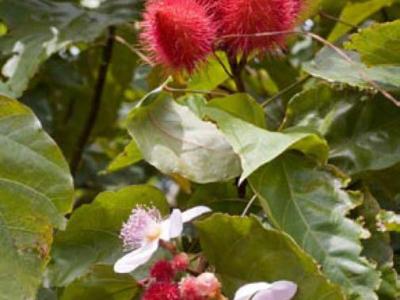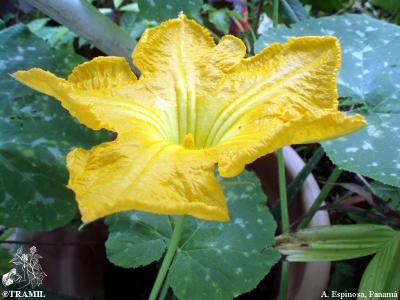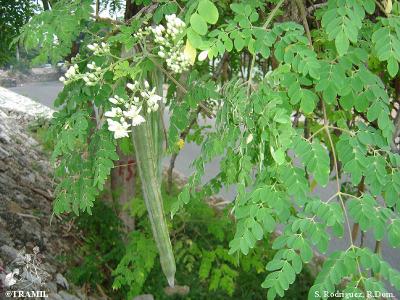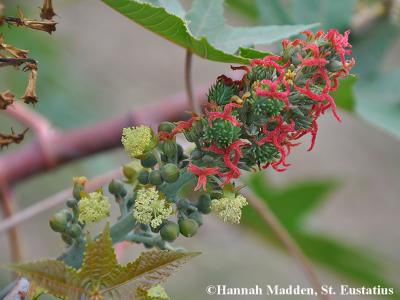(In territories with significant traditional TRAMIL use)
- bija
Haiti:
- woukou
seed, crushed, topical application2
crushed seed, fried in oil (coconut or other), topical application2-3
According to the information available:
The use for conjunctivitis is classified as REC based on the significant traditional use documented in the TRAMIL surveys, the toxicity studies and the scientific information published.
All applications in the eyes must follow the strictest hygiene measures, in order to prevent contamination or additional infection and to avoid contact with substances that can irritate to the conjunctiva.
The use for burns is classified as REC based on the significant traditional use documented in the TRAMIL surveys, the toxicity studies and the scientific information published.
Traditional use should be limited to superficial burns (epidermal damage) that are minor (less than 10% of the body surface) and located outside high-risk areas such as the face, hands, feet and genitals. Only use the preparation for local application.
All topical application must follow strict hygiene measures in order to prevent contamination or additional infection.
Seed oil taken orally can produce hypersensitivity reactions.
Not for use during pregnancy, breastfeeding or in children under 12 years.
The aril around the seed of Bixa orellana is a dye of relatively widespread human consumption.
For conjunctivitis:
Prepare a decoction with 30 grams of leaves in 4 cups (1 litre) of water, boil for 5 minutes in a covered vessel. Let the preparation cool down, strain (filter) with a cloth before performing an eyewash every 2-4 hours.
TRAMIL Work33
For superficial burns: Fry 10 grams of crushed seed in 40 millilitres of vegetable oil and leave to cool.
Wash the injury with boiled water and soap, apply on the affected area in sufficient quantities. Cover with a dressing or clean cloth and change every 12 hours.
Preparations must never be stored for more than 24 hours, even if refrigerated.
1 DELENS M, 1990
Encuesta TRAMIL en Barlovento, Edo. Miranda. Centro al Servicio de la Acción Popular CESAP, Caracas, Venezuela.
2 GERMOSEN-ROBINEAU L, GERONIMO M, AMPARO C, 1984
Encuesta TRAMIL. enda-caribe, Santo Domingo, Rep. Dominicana.
3 WENIGER B, 1987-88
Encuesta TRAMIL. enda-caribe, Santo Domingo, Rep. Dominicana.
4 GUPTA M, ESPOSITO AVELLA M, 1988
Evaluación química y farmacológica de algunas plantas medicinales de TRAMIL. CIFLORPAN, Universidad de Panamá, Ciudad de Panamá, Panamá. TRAMIL III, La Habana, Cuba, MINSAP/enda-caribe.
5 ANGELUCCI E, ARIMA HK, KUMAGAI EA, 1980
Annatto. 1. Preliminary data of the chemical composition. Col Inst Technol Aliments 11:89-96.
6 TIRIMANA ASL, 1981
Study of the carotenoid pigments of Bixa orellana L. seeds by T.L.C. Mikrochim Acta 2:11-16.
7 MERCADANTE AZ, STECK A, PFANDER H, 1997
Isolation and structure elucidation of minor carotenoids from annatto (Bixa orellana L.) seeds. Phytochemistry 46(8):1379-1383.
8 CRAVEIRO AA, OLIVERIRA CLA, A-RAUJO FWL, 1989
The presence of geranil-geraniol in Bixa orellana Linn. Quim Nova 12(3):297-298.
9 MERCADANTE AZ, STECK A, PFANDER H, 1999
Three minor carotenoids from annatto (Bixa orellana) seeds. Phytochemistry 52(1):135-139.
10 JONDIKO IJO, PATTENDEN G, 1989
Terpenoids and an apocarotenoid from seeds of Bixa orellana. Phytochemistry 28(11):3159-3162.
11 GALINDO-CUSPINERA V, LUBRAN MB, RANKIN SA, 2002
Comparison of volatile compounds in water- and oil-soluble annatto (Bixa orellana L.) extracts. J Agric Food Chem 50:2010-2115.
12 FELICISSIMO MP, BITTENCOURT C, HOUSSIAU L, PIREAUX JJ, 2004
Timeof-flight secondary ion mass spectrometry and X-ray photoelectron spectroscopy analyses of Bixa orellana seeds. J Agric Food Chem 52:1810-1814.
13 MERCADANTE AZ, STECK A, PFANDER H, 1997
Isolation and structure elucidation of minor carotenoids from annatto (Bixa orellana L.) seeds. Phytochemistry 46(8):1379-1383.
14 DUKE JA, ATCHLEY AA, 1986
Handbook of proximate analysis tables of higher plants. Boca Raton, USA: CRC Press. p27.
15 LAWRENCE BM, HOGG JW, 1973
Ishwarane in Bixa orellana leaf oil. Phytochem 12:2995.
16 HARBORNE JB, 1975
Flavonoids bisulphates and their co-occurence with ellagic acid in the Bixaceae, Frankeniaceae and related families. Phytochemistry 14(5-6):1331-1337.
17 HUAMÁN O, SANDOVAL M, ARNAO I, BEJAR E, 2009
Efecto antiulceroso del extracto hidroalcohólico liofilizado de hojas de Bixa orellana (achiote), en ratas. An Fac Med 70(2):97-102.
18 RAGA DD, ESPIRITU RA, SHEN CC, RAGASA CY, 2011
A bioactive sesquiterpene from Bixa orellana. J Nat Med 65(1):206-211.
19 CACERES A, SONIA GONZALEZ S, GIRON LM, 1998
Demostración de la actividad antimicrobiana de plantas tramil en base a los usos populares en la cuenca del Caribe. Informe TRAMIL. Laboratorio de Productos Fitofarmacéuticos Farmaya Guatemala, Guatemala.
20 WENIGER B, 1992
Etude sur Bixa orellana. Rapport TRAMIL. Faculté de Pharmacie, Université de Strasbourg, Illkirch, France. TRAMIL VI, Basse Terre, Guadeloupe, UAG/enda-caribe.
21 SERRANO G, SANDBERG F, 1988
Actividad antiinflamatoria de Bixa orellana: Informe preliminar TRAMIL. Universidad de Uppsala, Uppsala, Suecia. TRAMIL III, La Habana, Cuba, MINSAP/enda-caribe.
22 PAZOS L, COTO T, CAIZA F, 2008
Antiinflamatorio tópico, en ratones, de las semillas de Bixa orellana. Informe TRAMIL, Laboratorio de Ensayos Biológicos, LEBi, Universidad de Costa Rica, San Pedro, Costa Rica.
23 GEORGE M, PETALAI KM, 1949
Investigations on plant antibiotics. Part IV. Further search for antibiotic substances in Indian medicinal plants. Indian J Med Res 37:169-181.
24 ROJAS JJ, OCHOA VJ, OCAMPO SA, MUÑOZ JF, 2006
Screening for antimicrobial activity of ten medicinal plants used in Colombian folkloric medicine: A possible alternative in the treatment of non-nosocomial infections. BMC Complement Altern Med 6:2.
25 PAZOS L, COTO T, CAIZA F, 2008
Toxicidad oral aguda, dosis repetida, en ratón, semillas de Bixa orellana. Informe TRAMIL. Laboratorio de Ensayos Biológicos, LEBi, Universidad de Costa Rica, San Pedro, Costa Rica.
26 GARCIA D, SAENZ T, 1995
Toxicidad aguda de algunas plantas TRAMIL. Informe TRAMIL. Farmacognosia, Facultad de Farmacia, Universidad de Sevilla, Sevilla, España.
27 MARTINEZ MJ, BETANCOURT J, LOPEZ M, MOREJON Z, FUENTES V, MORON F, 2005
Irritabilidad dérmica de semilla seca de Bixa orellana. Informe TRAMIL. Laboratorio Central de Farmacología, Facultad de Ciencias Médicas “Dr. Salvador Allende”, La Habana, Cuba.
28 MARTINEZ MJ, BETANCOURT J, LOPEZ M, MOREJON Z, FUENTES V, MORON F, 2005
Clases Tóxicas Agudas tópica de semilla seca de Bixa orellana. Informe TRAMIL. Laboratorio Central de Farmacología, Facultad de Ciencias Médicas “Dr. Salvador Allende”, La Habana, Cuba.
29 Solis PN, Olmedo D, Buitrago de Tello RE, Gupta MP, 2000
Estudio fitoquímico y toxicológico de algunas plantas TRAMIL. Informe TRAMIL. Centro de Investigaciones Farmacognósticas de la Flora Panameña CIFLORPAN, Facultad de Farmacia, Universidad de Panamá, Panamá, Panamá.
30 PAZOS L, COTO T, CAIZA F, 2008
Irritación ocular, en conejos, del jugo de hojas de Bixa orellana. Informe TRAMIL. Laboratorio de Ensayos Biológicos, LEBi, Universidad de Costa Rica, San Pedro, Costa Rica.
31 PAUMGARTTEN FJ, DE-CARVALHO RR, ARAUJO IB, PINTO FM, BORGES OO, SOUZA CA, KURIYAMA SN, 2002
Evaluation of the developmental toxicity of annatto in the rat. Food and Chemical Toxicology 40(11):1595-1601.
32 SILVA DELGADO H, DEL AGUILA A, GODOY PEREZ L, PORTOCARRERO P, 1998
Clinical evaluation of Bixa orellana L. achiote in female volunteers. Phase I Study. Biodiversidad Salud 1(1):38-41.
33 CARBALLO A, 1995
Plantas medicinales del Escambray cubano. Informe TRAMIL. Laboratorio provincial de producción de medicamentos, Sancti Spiritus, Cuba.






